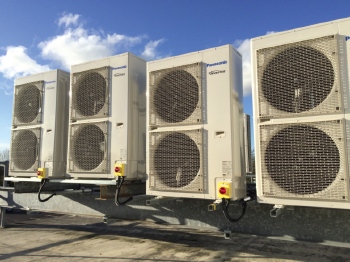A final look at R22
Several months have elapsed since the use of R22 for maintaining air-conditioning systems was banned in the UK. But there is still lots of kit out there. Ken Sharpe sounded out views of the industry of the benefits to be gained when those systems are finally replaced.
For a number of years the efficiency of air-conditioning system has been increasing by leaps and bounds. Indeed, the pace of improvement seems to have increased even in the last year.
The improvement is enormous, according to Mark Grayson, VRF product manager with Mitsubishi Electric. He says, ‘We have seen several innovative improvements in component design, such as the use of more efficient materials like aluminium and design in elements such as heat exchangers. This already delivers systems that are significantly more efficient than their counterparts from even five years ago and offer more than double the efficiency levels of systems that are 10 to 15 years old.’
Much equipment of that age that survives is probably using R22, the use of which was banned for new equipment in 2001, or 2004 for small air-conditioning systems.
The general belief is that there is a huge amount or air-conditioning equipment in use still using R22. David Dunn, general manager of Toshiba Air Conditioning, says, We believe there is a very significant amount of equipment out there still reliant on R22, How much, we simply don’t know, which is why we have launched our data-collection initiative on R22 equipment.’
‘The issue is not so much in relation to the major players such as national chains, which are well informed about the new requirements and have already taken action. It is the small operators of commercial buildings, offices, shops and hotels — all of whom rely on air conditioning, but who are not as well informed as they might be about what the phase-out means for them.’
Since the start of this year, there has been a ban on all forms of R22 for topping up equipment. That, explains David Dunn, means that anyone who has an urgent service need due to accidental damage of equipment or a cumulative leak will face a serious, urgent and potentially costly problem.
The best time for action is before an urgent problem occurs, and the general advice is against the use of a drop-in HFC that is compatible with the system’s existing oil.
Martin Passingham, Daikin UK’s product manager, says, ‘Such retrofits are not a reliable option to bring plant up to scratch as they are likely to compromise system performance. Installers should therefore recommend replacement technology to hotels and retailers, for example, since their business success largely depends on the flawless operation of HVAC equipment and a balanced indoor climate.’
Other benefits of replacing R22 equipment come from Jody Lees, head of LG’s air conditioning and energy solutions. He argues, ‘With R22 replacement, the building occupier will save on operational costs due to the efficiency of newer systems, but the internal comfort will be better due to manufacturers’ smart controls — and this can save even more energy as the indoor units can be individually controlled and scheduled. The controllers are far easier to use these days; many are intuitive.’
Even the best-maintained air-conditioning system will see its performance fall off over time, says Mike Nankivell, marketing and business development director at Space Airconditioning. He explains, ‘Even with an exemplary maintenance regime, any air-condition system has a finite life expectancy. Poor performance may simply be a consequence of age-related defects or that the system, as originally designed, can no longer satisfy the current demands of the building. In such cases,it can make very sound economic sense to consider renewing the equipment.’

Like Mitsubishi’s Mark Grayson, Mike Nankivell also remarks on the energy efficiency of modern equipment. He comments, ‘In the past couple of decades, we have seen many truly impressive and innovative developments in the energy efficiency of cooling technologies. Perhaps the most effective improvements cam about from the realisation that systems were designed to operate under the most extreme conditions.
‘In reality most systems spend much of the time operating at no more than 50% of their design capacity. Enter such technologies as mechanical and electronic variable-speed or inverter control. These were probably the most effective means of increasing part-load efficiency.’
Toshiba’s David Dunn also points to the efficiency of new equipment. ‘There is a strong case to be made for replacement on grounds of improved efficiency and reduction in ongoing running costs — and, of course, you can benefit from a new total-peace-of-mind warranty.
‘Modern equipment is much more efficient than older R22 kit. Running and servicing costs can be less than half those of equipment that may be, perhaps, a decade old and yesterday’s technology.’
But there can be more to replacing an existing cooling system than just more efficient cooling. As Mike Nankivell explains, a major development has been the acceptance that the energy consumption of comfort-cooling systems can be largely compensated by also being able to heat extremely efficiently at little or no extra costs. Today we have an air-conditioning market dominated by heat-pump/heat-recovery technologies.’
And for those who are concerned about the disruption that might be caused by replacing R22 system, Daikin’s Martin Passingham offers reassurance. For example, he describes Daikin’s VRV-Q System as a tried-and-tested flexible replacement option. He explains, ‘It can re-use existing refrigerant pipes as well as the in situ wiring to keep cost down while it is phased in. Fast installation means that the customer’s daily business is not interrupted during the upgrade.’
And there are plenty of other companies that offer similar replacement VRF systems.
Let Mike Nankivell have the last word. ‘Replacing an aging air-conditioning asset can be a very worthwhile investment that not only results in vastly improved operational performance but also significant cost reductions.’







